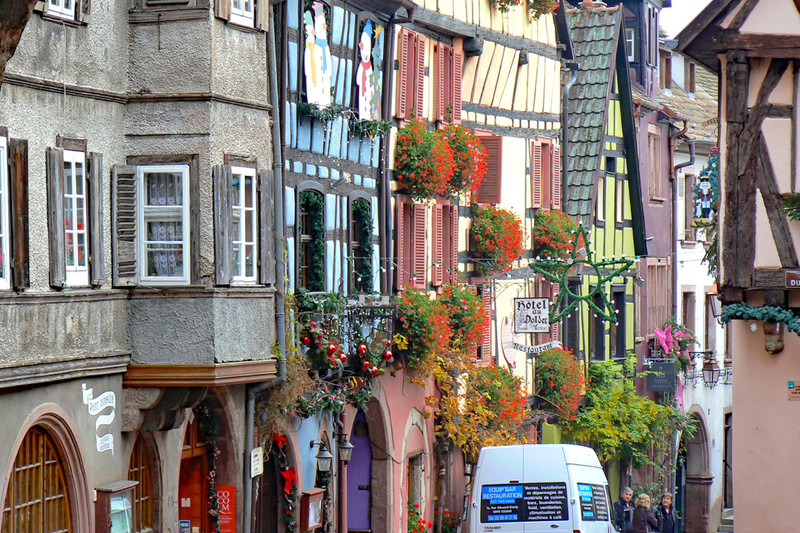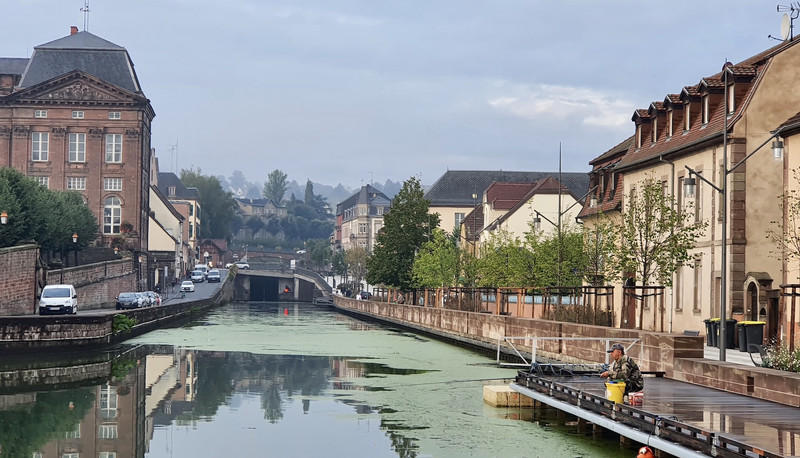Introducing Alsace
Alsace in north-east France has a unique character, partially shaped by it passing back and forth between France and Germany. Its strategic location on the western bank of the Rhine river, one of the most important trading routes of Europe, has given Alsace more feudal castles than any other region of France. The German influence is strong and can been seen in the tradition of painting buildings according to the nature of their business – bakeries in one colour, butchers in another, etc. The resulting colourful streets of half-timbered buildings with geranium filled window boxes create picture-postcard villages.
The Vosges Mountains form the backbone of Alsace with the alluvial plain and the marshes of the Ill and Rhine rivers running along its eastern flank. The distinctive rounded summits, known as ballons, are bare of trees, but the rest of the mountains are blanketed in forest, from chestnuts above the vines, to beech, conifers, mountain ash and maple, creating a paradise for birds and other wildlife.
Storks are reputed to bring good luck and are a welcome and common sight in Alsace, migrating there from Africa to raise their young. Their large nests can be seen on roofs and trees in town and country, even in cities like Strasbourg. Strasbourg also has a remarkable Gothic cathedral, dating from the 11th century, notable museums and a picturesque historic centre encircled by the river Ill. Colmar is almost as pretty and is the centre of the wine route, and the home of the famous Musée d’Unterlinden in a former 13th century convent. Alsace boasts a wide variety of museums, including an Eco-museum with over 50 ancient timber-framed houses and around Mulhouse you’ll find the National Automobile Collection (including 120 Bugattis), a railway museum, a printed fabric museum, a wallpaper museum, a fire brigade museum and an electricity museum. Something for everyone.
Alsace is renowned for its food and wine and also produces 56% of France’s beer. Vineyards fill the warmer lower slopes of the Vosges Mountains and produce aromatic wines from Gewurztraminer, Reisling, Sylvaner, Pinot Gris, Pinot Blanc and Muscat grapes, plus a light, fruity Pinot Noir.
The Vosges Mountains are interspersed with walking and cycling trails and much of the canal towpath has been up-graded for cycling and walking, making Alsace a haven for active holidays. We have a selection of easy to moderate cycling holidays starting from Strasbourg, plus a new route from Basel, which is very convenient for the EuroAirport.
For non-cyclists we have walking holidays in Alsace, including three along the Medieval Trail, which is almost 300kms long, winding through the Vosges Mountains from Wissembourg in the north to the wine village of Kaysersberg in the south.
Boating in Alsace is equally glorious as the Canal de la Marne au Rhin heads west from Strasbourg into the Zorn Valley and through the Vosges Mountains to the Lorraine Plateau and a regional park of lakes, ponds and marshes with wonderful birdlife. The Panache meets guests in Strasbourg for a unique barge cruise, which includes the famous Arzviller boat lift – a sealed lock that goes sideways up a slope, rising 44.5m and replacing 17 locks. That is spectacular enough, but it is followed by two tunnels! Rental boats are also available for independent exploration and Le Boat, Nicols and Canalous offer a wide range of boats from several bases.



